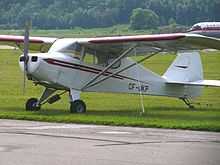Piper PA-15 Vagabond
The Piper PA-15 Vagabond and PA-17 Vagabond are both two-seat, high-wing, conventional gear light aircraft that were designed for personal use and for flight training and built by Piper Aircraft starting in 1948.[1][2]
Development
The PA-15 was the first post-World War II Piper aircraft design. It utilized much of the same production tooling that created the famous Piper Cub, as well as many of the Cub structural components (tail surfaces, landing gear, most of the wing parts).[3] The Vagabond has a wing that is one bay shorter (30 ft (9.1 m) versus 36 ft (11.0 m)) than that on the Cub, which lead to the unofficial term describing the type: Short-wing Piper. This allowed the aircraft to be built with minimal material, design and development costs, and is credited with saving Piper Aircraft from bankruptcy after the war.
Vagabonds used a new fuselage with side-by-side seating for two instead of the Cubs' tandem (fore and aft) seating.[2]
The PA-17 Vagabond version features dual controls, enabling it to be used for pilot training. It has a bungee cord shock-absorbed landing gear (solid gear on the PA-15), and a 65 hp (48 kW) Continental A-65 engine.[1]
The Vagabond was followed by the Clipper, which is essentially a Vagabond with a 17 in (43 cm) longer fuselage, Lycoming O-235 engine of 108 hp (81 kW), extra wing fuel tank, and four seats, the Pacer, Tri-Pacer and Colt, which are all variations of the Vagabond design and thus all Shortwing Pipers.[1][2]
Operational history

In March 2010 there were still 224 PA-15s[4] and 125 PA-17s[5] registered in the USA.
There were 13 PA-15s and 12 PA-17s registered in Canada in March 2010.[6]
Variants


- PA-15 Vagabond
- Side-by-side two-seater powered by one 65hp Lycoming O-145 engine, 387 built.
- PA-17 Vagabond
- Also known as the Vagabond Trainer a variant of the PA-15 with dual-controls, shock-cord suspension and powered by one 65hp Continental A-65-8 engine, 214 built.
Specifications (PA-15)
Data from 1978 Aircraft Directory[1]
General characteristics
- Crew: one pilot
- Capacity: one passenger
- Length: 18 ft 8 in (5.69 m)
- Wingspan: 29 ft 3 in (8.92 m)
- Empty weight: 620 lb (281 kg)
- Gross weight: 1100 lb (498 kg)
- Powerplant: 1 × Lycoming O-145, 65 hp (49 kW)
Performance
- Maximum speed: 100 mph (163 km/h)
- Cruise speed: 90 mph (146 km/h)
- Range: 250 miles (405 km)
- Service ceiling: 10,000 ft (3077 m)
- Rate of climb: 510 ft/min (2.6 m/s)
See also
Related development:
- Piper Pacer
Comparable aircraft:
References
- ↑ 1.0 1.1 1.2 1.3 1.4 Plane and Pilot: 1978 Aircraft Directory, page 59. Werner & Werner Corp, Santa Monica CA, 1977. ISBN 0-918312-00-0
- ↑ 2.0 2.1 2.2 Montgomery, MR and Gerald Foster,: A Field Guide to Airplanes - Second Edition, page 72. Houghton Mifflin Company, 1992. ISBN 0-395-62888-1
- ↑ "The Vagabond Story". Sport Aviation. January 1961.
- ↑ Federal Aviation Administration (June 2008). "Make / Model Inquiry Results". Retrieved 2010-03-24.
- ↑ Federal Aviation Administration (June 2008). "Make / Model Inquiry Results". Retrieved 2010-03-24.
- ↑ Transport Canada (March 2010). "Canadian Civil Aircraft Register". Retrieved 24 March 2010.
External links
![]() Media related to Piper PA-15 Vagabond at Wikimedia Commons
Media related to Piper PA-15 Vagabond at Wikimedia Commons
| ||||||||
| ||||||||||||||